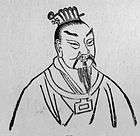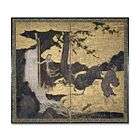Xu You (hermit)
Xu You or Hsü Yu (simplified Chinese: 许由; traditional Chinese: 許由; pinyin: Xǔ Yóu) was a legendary Chinese recluse who lived during the reign of the Emperor Yao (traditionally c. 2356–2255 BC), residing next to the Ying River. The emperor allegedly offered him the royal throne towards the end of his rule.
Life


Xu You denounced the society and retreated to the north of Ying River.[1] Living a simple life, he scooped river water with his bare hands, even though he had a hulu (an ancient water bottle shaped like a gourd).[2] Xu was a disciple of the female teacher Gnaw Gap,[3] whom Xu described as "[blending] a myriad things [...] senior to high antiquity but is not aged".[4] The legendary ruler Emperor Yao regarded Xu with utmost respect and requested that he be his teacher. They shared a positive relationship, towards the end of Yao's rule (traditionally believed to be circa 2256 BC),[5] the ruler chose Xu as his successor.[6] (Much later, the Chinese sage Confucius greatly lauded Yao's decision to appoint Xu as the next emperor in line.[7]) However, Xu refused to accept the throne, commenting that he had "no need for all under heaven".[8] Legend goes on to state that an abashed Xu "washed out" his ears' contents into the Ying River, contaminating it.[9] After Xu died, he was apparently buried at the summit of Mount Chi. The Han Dynasty "Grand Historian" Sima Qian mentioned Xu in a chapter of his work Records of the Grand Historian. Sima personally visited the alleged grave of Xu and wrote that Xu was an epitome of "highest virtue".[10] Xu You is also depicted in a seventeenth-century Japanese artwork titled Xu You and Qao Fu, illustrating the popular tale of another fellow hermit detouring from the Ying River because of the filth Xu had contributed to it by washing out his ears there. It is now housed at the British Museum.[11]
References
- ↑ Zhuangzi 1998, p. 294.
- ↑ "Kenko's Esteem for Hermits in his Essays in Idleness". Hermitary. Retrieved September 19, 2013.
- ↑ Zhuangzi 1998, p. 105.
- ↑ Zhuangzi 1998, p. 63.
- ↑ Friedrich Alexander Bischoff (1985). The songs of the Orchis Tower. O. Harrassowitz. pp. 133–. ISBN 978-3-447-02500-3.
- ↑ Youlan Feng; Ernest Richard Hughes (1970). The Spirit of Chinese Philosophy: Translated by E. R. Hughes. Greenwood. pp. 144–.
- ↑ Strand, Clark. "Green Koans Case 30: Hsu-Yu Refuses the Emperor". Tricycle.
- ↑ Zhuangzi 1998, p. 6.
- ↑ Keith Weller Taylor (1983). The Birth of Vietnam. University of California Press. pp. 347–. ISBN 978-0-520-07417-0.
- ↑ Watson, Burt (1958). "Ssu Ma Chien Grand Historian Of China". Columbia University Press.
- ↑ "Xu You and Qao Fu, a 2-fold screen painting". Retrieved September 19, 2013.
Bibliography
- Zhuangzi (1998). Wandering on the Way: Early Taoist Tales and Parables of Chuang Tzu. University of Hawaii Press. ISBN 978-0-8248-2038-1.